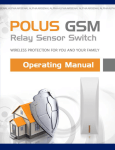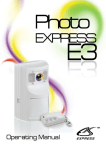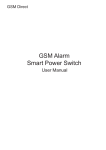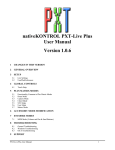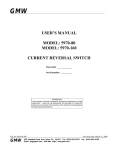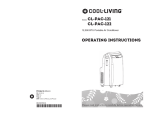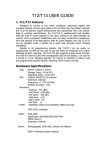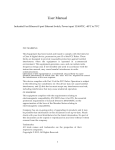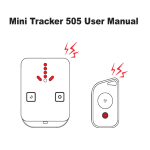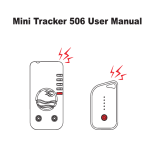Download Operating manual - Compound Security Systems
Transcript
3 POLUS GSM THERMO SENSOR DETECTOR ALARM Operating manual TABLE OF CONTENTS 1 Description and Operation 4 1.1 1.2 1.3 1.4 1.5 1.6 Function GSM Thermo Sensor Detector Alarm Package Contents Technical Specifications GSM TSDA Structural Design External Temperature Sensor Structural Design Function and Operation of the GSM TSDA 4 4 5 5 6 7 2 Set-Up 9 2.1 2.2 2.3 2.4 2.5 2.6 2.7 Preparing and Operating the GSM TSDA Configuring the GSM TSDA Accessing the Programming mode Setting-up for the First Time Use Verifying set-up Changing & Adjusting the Parameters GSM TSDA Installation 9 9 10 11 12 12 13 3 Troubleshooting the GSM THERMO Sensor Alarm Detector 14 4 Contact Us 15 5 Warranty 15 4 1 1.1 - - 1.2 Description and Operation Function The GSM THERMO Sensor Alarm Detector is designed to monitor temperature in a controlled environment, and when pre-set temperature thresholds are triggered in the monitored zone, it will transmit an SMS “ALARM” notification and/ or place a call to your mobile telephone (up to six (6) numbers). The GSM TSDA is designed to monitor temperature in apartments, homes, country retreats, steam rooms, saunas, garages, basements, vegetable storage units, incubators, refrigerators, greenhouses, automobiles, outdoor facilities,etc.; it can also be used to monitor devices placed and located near the Thermo Sensor, such as radiators, hot water heating system pipes, heated floors, etc.. The GSM TSDA supports the following operational modes: Programming; “Armed On Guard”; “Alarm”; “Standby”; GSM THERMO Sensor Detector Alarm FEATURES: Installs at any location with mobile GSM reception; Automatically resets to “Armed On Guard” mode after a triggered Alarm; The GSM TSDA is capable of monitoring temperature using the built-in or the external Thermo Sensor*, as well as by using two external Thermo Sensors simultaneously; Arms and Disarms by simply turning power on or off. Settings programmable via mobile telephone, online and thru utilizing “Configurator Express GSM” Android, iOS apps and the “GSM Central Control Monitoring Panel; Uses two notification languages: English and Russian; Operates on a single 3 volt CR123 lithium battery for up to 12 months; Automatically identifies remaining SIM card balance inquiry telephone number; *- The external Temperature Sensor is activated or de-activated by connecting or dis-connecting the external Temperature Sensor cable jack into or out of the Detector Alarm socket. The built-in Temperature Sensor can be dis-abled by setting unattainable temperature values (cells No.28&29, Table4). The GSM TSDA is designed to operate indoors or near the item to be monitored and to monitor around the clock 24/7 in stable non-extreme and non-explosive conditions. Package Contents Include in accordance with Table 1. Table 1- Contents Description Quantity GSM Thermo Sensor Detector Alarm - (1) one Lithium CR123A 3V battery- (1) one External temperature Sensor DS18B20 (cable L=1.5m, jack 2.5mm)- (1) one User's Manual- (1) one 5 1.3 Technical Specifications in accordance with Table 2. Table 2- Primary Technical Specifications DESCRIPTION VALUE Max. Number of telephones notified(6) six Time lapse for notification20-40 seconds GSM Module Operating StandardsGSM-800/900/1800/1900 Detector temperature operating rangefrom -10* to +50 C Temperature measuring range of the from -10 to +50 C Built-in Sensor (limited to temp. operating Range of the GSM TSDA)Temperature measuring range of the from -40 to +99 C External temperature SensorBattery type1 x CR123A 3 V Uninterrupted operating life span using one up to 12 months battery at a temperature of +25CEnclosure durability levelIP40 93% Relative operating humidity @ +35С сondensation, not to exceedGSM TSDA size & dimensions 109x32x27.5 mm do not exceedGSM TSDA (w/ battery) weight 60 g does not exceedTemperature Sensor cable length1.5 m * Please Note: The GSM TSDA can operate at a temperature of -25 C, but the operating battery life span and quantity of SMS’s sent will be reduced. 1.4 GSM TSDA Structural Design The GSM TSDA unit consists of a cover body with a LED indicator and a base (diag. 1 & 2). The cover body has an opening (with pop-out plug) to connect the external Temperature Sensor (diag. 2). Inside the cover body, mounted on the base, is the controller circuit board, to which the GSM module is attached (diag. 3). The circuit board and cover body attach to the base unit using clips. The cover body and base unit are made of ABS plastic. 6 Diagram 1: GSM TSDA design; General view Diagram 2: GSM TSDA Design; Top & bottom view The controller circuit board (refer to diagram 3) contains a: battery holder GB1, audio indicator BQ1, two color LED indicators VD1 and a socket XS4 in order to connect a Temperature Sensor. The two color LED indicates the state of the GSM TSDA in accordance with table 3. The GSM module circuit board contains a SIM cardholder (XS3) and a “GSM” LED to indicate network signal strength. Diagram 3: Exposed view of the controller circuit board and GSM module The GSM TSDA is shipped with an installed battery insulated from the contacts by a protective plastic insert (refer to diagram 7). 1.5 External Temperature Sensor Design The external Temperature Sensor is functionally identical to the built-in Temperature Sensor (BK1). The external Temperature Sensor is enclosed in a metal casing to which a 1.5 meter cable with a 2.5 mm jack is attached (see diag.4). 7 Diagram 4: External Temperature Sensor 1.6 Function and Operation of the GSM TSDA 1.6.1 Operational Principle of the GSM TSDA While in “Armed On Guard” mode, when the set temperature thresholds are exceeded, the GSM TSDA will receive an Alarm trigger signal from the Sensor, enter “ALARM” mode and will then execute notifications. 1.6.2 Primary Functions of the GSM TSDA The GSM TSDA executes the following functions: - Manages temperature in a monitored zone (spot); - Transmits SMS notifications and/or calls the list of notification telephone numbers (up to six (6) numbers) programmed into the GSM TSDA SIM card memory when an “ALARM” is triggered; - Automatically resets to “Armed On Guard” mode and transmits an SMS to the primary notification telephone number; - Automatically, requests remaining GSM TSDA SIM card balance and transmits an SMS to the primary notification telephone number; 1.6.3 Operational modes of the GSM TSDA Upon activating power (by either removing the protective plastic insert from in between the battery and contacts or by inserting a battery), the GSM TSDAwill discover and connect to a GSM network and then enter “Programming” mode; One (1) minute after all the settings conclude, the GSM TSDA enters “Armed On Guard” mode. While in “Armed On Guard” mode and when the pre-set temperature thresholds (low or high) are violated, the GSM TSDA will enter “ALARM” mode and will then execute notifications via SMS and/ or by placing outgoing calls. After concluding “ALARM” notifications, the GSM TSDA enters “Stand By” mode. While in “Stand By” mode, sensing no violations (when the temperature returns to within 2 degreesof the pre-set temperature low or high thresholds), the GSM TSDA automatically resets to“Armed On Guard” modeand transmits an SMS (Diag.6) to the primaryNotification telephone number. The GSM TSDA is “Disarmed” by interrupting the power source by either replacing the protective plastic battery insert or by removing the battery. 8 1.6.4 GSM TSDA Indicators The GSM TSDA has built-in LED and sound indicators. In addition, the GSM LED indicates GSM signal strength. Indicator descriptions can be found in Table 3. Table 3- GSM TSDA Indicators GSM LED Indicator Glows Red 3 Sec. Flashes for 20-40 Sec. Event/ Mode LED Indicator Sound Indicator Power On Glows Red ― GSM Network Search Glows Red ― Flashes Red/Green 3 Beeps Once every 4sec. Glows Green ― ― ― Audio Beep ― ― ― ― Glows Red ― ― Glows Green ― ― ― ― ― GSM Network Activation (At Start-up) Programming Mode GSM TSDA Incoming Call or SMS “Armed On Guard” Mode “Alarm” Mode High Temp. Threshold “Alarm” Mode Low Temp. Threshold “Standby” Mode 1.6.5 Notifications The GSM TSDA transmits “ALARM” SMS notifications to the numbers registered at “1SMS”…”6SMS” (Diag.5). The primary number registered at “1SMS” will receive SMS notifications containing the selected settings (Item 2.4, diag. 8), Test/status SMS notifications showing remaining SIM card balance and Auto Reset to “Armed On Guard” mode (Diag. 6). Test/status SMS notifications are sent depending on the interval selected (Table 4, Cell# 14). The interval time reference point is established and starts upon the receipt of the settings notification. When an “Alarm” is triggered, the GSM TSDA will transmit an SMS notification, place a call to the first registered (primary) number and will then place calls to the remaining numbers together with transmitting SMS notifications (up to six (6) numbers). The GSM TSDA will cease calling the first number and will proceed to call the next number under the following circumstances: - When the subscriber disconnects the incoming call; - When the subscriber does not respond by picking-up within 30 seconds; - When the subscriber’s line is busy; - When the subscriber is out of network; Calling out will cease after one of the subscriber numbers picks up and disconnects; then the GSM TSDA will transmit “Alarm” (Diag. 5) notifications to the numbers located at cell positions “2SMS”…”6SMS”. 9 High temperature detected Тn SNN% Low temperature detected Тn SNN% Diag. 5 “ALARM” Notifications Тn normal SNN% Diag. 6 Auto Reset Notification Tn- Temperature Sensor number: T1 or T2 T1- Built-in Temperature Sensor, T2- External Temperature Sensor S- indicates GSM network signal strength; NN- indicates GSM network signal strength as a percentage (e.g. S50%, S75%, etc.) The value indicating GSM network signal strength (SNN%) is included in all SMS notifications, except for notifications showing remaining SIM card balance. 2 Set-Up 2.1 Preparation of the GSM TSDA for Operation After opening the package, visually inspect the GSM TSDA for any physical defects and to confirm all item parts are included. Prior to operating the GSM TSDA, disable the PIN number request feature on the SIM card with the assistance of a mobile telephone (refer to mobile telephone user’s manual). Check and verify there is a sufficient balance on the SIM card. 2.2 Configuring the GSM TSDA At initial power-up, the GSM TSDA records on to the SIM card the following parameters and values in accordance with Table 4. Table 4- GSM TSDA Settings Cell Default Cell# label Value 1 1sms 000 2 3 4 5 6 2sms 3sms 4sms 5sms 6sms 000 000 000 000 000 7 BALANS 0 Description Available Values 1st telephone number (primary) for notification Enter number in the following format +1********** e.g.:+17180000000 Telephone numbers for notification Enter number in the following format +1********** e.g.:+17180000000 Remaining balance Inquiry USSD Auto detection of remaining balance tel. number; Manual entry of tel.# e.g.: *100# 10 Cell# Cell label Default Value 14 TEST 7 18 AlarmNt 1 Description Available Values Frequency for test/ status SMS notifications Alarm notification Option/Type during Alarm mode Sets frequency for test/ status SMS notifications. Interval sets up to 250 days. e.g.: 1- Notification once a day 7- Notification once a week 0- Notification not sent. 0- Only SMS to 1sms...6sms 1- Call + SMS (SMS sent to1sms, then calls placed to all tel. numbers, followed by SMS transmittal to all remaining tel. numbers @2sms... 6sms. 3- Only calls placed to 1sms...6sms Upper Temp. Threshold for built-in Increments of 1 degree C, Sensor from -10 C to +50 C (asterisk) indicates (-)minus; Lower Temp. 29 Tdown1 10 Threshold for built-in (+) plus not required Sensor Template name 34* POLUS 3 3 w/settings For operation w/Polus 35 Мnum 000 Tel.№ Alarm Sensor GSM Security Panel application Notification 0-Ru 36 LANG 1 Language 1-En Upper Temp. 38 Tup2 40 Threshold for Increments of 1 degree C, external Sensor from -10 C to +50 C (asterisk) indicates (-)minus; Lower Temp. (+) plus not required 39 Tdown2 10 Threshold for external Sensor *- Operating service data that creates template during GSM TSDA set-up. 28 2.3 Tup1 40 Accessing the Programing Mode In order to access “Programing” mode, consecutively execute the following actions. 1. Install the SIM card as shown in diag. 7. Caution! Prior to installing or removing the SIM card, it is necessary to de-activate the GSM TSDA electrical supply! (i.e. install the protective plastic battery insert or remove the battery). 2. Remove the Protective Plastic battery Insert from in between the contacts and the battery (see diag. 7) or install a battery using correct polarity (if previously removed). 11 Diag. 7 SIM card installation; protective plastic battery insert removal 3. The GSM TSDA LED indicator will glow red. The “GSM” LED will glow for 3 seconds and will begin to flash quickly. 4. Wait for the SIM card to register on to the GSM network. At the conclusion of registration, 3 beeps will be heard and the “GSM” LED will flash (1) once every (4) four seconds. The GSM TSDA LED indicator will glow green. This indicates that the GSM TSDA has entered “Programing” mode. During the entire duration of the “Programing” mode, the LED indicator will glow green. In the event the “GSM” LED continues to flash quickly, (the SIM card is not registering on the GSM network) and might be due to the SIM card being incorrectly or not installed, blocked by a PIN code or the GSM network is inaccessible (take steps in accordance with table 5). Upon entering “Programing” mode, the GSM TSDA sends an SMS notification with settings to the primary notification telephone number (if the primary number was previously recorded in the SIM card memory). For the span of (1) one minute, the GSM TSDA remains in “Programing” mode and stands by for an incoming call and/ or SMS containing any changes to the settings. In the absence of an incoming call/ SMS, the GSM TSDA at the expiration of (1) one minute enters “Armed On Guard” mode. In the event of an incoming call/ SMS occurring and being accepted, the GSM TSDA at the expiration of (1) one minute, will enter “Armed On Guard” mode and will transmit an SMS notification reflecting the setting changes to the primary registered telephone number. 2.4 Setting-up for the First Time After powering-up the GSM TSDA, a template with cells containing default values will be created in the SIM card phone book (in accordance with table 4). Later on, you are able to edit and alter these parameters and values. It is necessary to record notification telephone numbers to the SIM card memory. Perform the followings steps consecutively. 1. Access “Programing” mode in the device (see item 2.3). 2. Begin by calling the GSM TSDA SIM card telephone number from the telephone number that will be used as the primary notification number. After receiving and recording the number, the GSM TSDA will disconnect the call and emit (1) one audible confirmation beep. This number will be recorded in cell# 1 “1SMS” (see table 4) as the designated primary number and will send an SMS notification from the GSM TSDA indicating “Setting Reset, Number Added +1xxxxxxxxxx”. 12 3. Proceed to record any additional notification telephone numbers by calling from each of them and after each additional number is recorded, an SMS notification is sent to the primary telephone number containing “Number Added+1zzzzzzzzzz”, “Number Added+1zzzzzzzzzz” etc. 4. One (1) minute after the last call is received, the GSM TSDA will transmit an SMS containing the settings (see diag. 8) to the primary telephone number and will then enter “Armed On Guard” mode. If you were unable to record all the necessary additional notification telephone numbers, either re-insert in the Protective Plastic Insert between the battery and contacts or remove the battery, wait (2) two minutes and then repeat the procedure from the beginning- see item 2.6. 1) Primary notification number 14) Frequency of test/status Notifications 18) Alarm notification option Received from +1YYYYYYYYYY 1)+7XXXXXXXXXX,7)*100#, 14)7,18)1,28)40,29)*10, 36)1,38)40,39)*10,SNN% 28) Upper Temp. Threshold 2 29) Lower Temp. Threshold 2 Signal Strength GSM TSDA number 7) Balance Inquiry 28) Upper Temp. Threshold 1 29) Lower Temp. Threshold 1 36) Notification language Diag.8- Sample SMS with Settings 2.5 Verifying Set-up 1. Attach the external Temperature Sensor by inserting the jack into the GSM TSDA XS4 socket. 2. Place the Temperature Sensor in a location where the temperature exceeds 40 degrees Celsius (e.g. place under a hot lamp). 3. Within a few seconds, the GSM TSDA LED indicator will glow Red and will trigger into “ALARM” mode. (afterwards, place the Temp. Sensor in normal conditions by removing it from under the hot lamp). 4. Wait to receive an SMS notification containing the text “High Temperature Detected T2” and an incoming telephone call from the Alarm Detector (acknowledge by disconnecting the incoming call). After the concluding the notifications, the LED indicator will turn off and the GSM TSDA will enter “Standby” mode. 5. After the Temperature Sensor cools off (temperature falls below 38 C), the GSM TSDA automatically resets and enters “Armed On Guard” mode. Wait to receive an SMS showing “T2 Normal”. 2.6 Changing the Parameter Value Settings Value parameter settings are installed during the (1st) first power-up and can later be changed. The parameter values can be changed using the following methods. Method-1 The GSM TSDA settings can be configured by using the “Online Service” located at service.alphasafe.com, by utilizing the “Express GSM Configurator” for Android or iOS or by using the application for central monitoring “GSM Panel” available for download from play.google.com (search: “Express GSM” or “GSM Panel”). The created configuration will be sent to the GSM TSDA SIM card. 13 Method-2 1. Using the primary notification telephone, create an SMS message using values in accordance with table 4. For example, in order to change the notification method, it is necessary to send an SMS message containing the following text(Characters are entered without quote marks and spaces): “18)0”; where 18) indicates the cell number and 0 indicates the selectedparameter value. In order to change several parameters at once, it is necessary to list the parameters separating them with a comma. For example: “2)+1xxxxxxxxxx,18)3,28)25,29)15,36)1,38)95,39)*30” etc. Note: Characters are entered without quote marks and spaces. 2. Access “Programing” mode in the GSM TSDA (item 2.3). 3. Send a previously prepared SMS message to the GSM TSDA telephone (SIM card) number. 4. Wait to receive an SMS notification confirming the selected parameter values. Method-3 It is possible to change and configure the parameter values directly with the aid of a GSM mobile telephone. In order to accomplish this, install the GSM TSDA SIM card into any GSM mobile telephone. To access the necessary parameter, open the telephone book, select the cell to be altered and make the necessary changes in accordance with table 4. For example, in order to change the primary notification telephone number, in the telephone book select “1SMS”, then select “change”, erase the old number and record the new primary notification telephone number, etc. Note: Some mobile telephone models do not support this function. In addition to the change parameter methods listed above, adding/ deleting notification telephone numbers can also be accomplished via a telephone call from the primary notification telephone number to the GSM TSDA while in “Programing” mode. After calling from the primary notification telephone number, all telephone numbers contained in the SIM card memory are erased and it will be necessary to re-add all required telephone numbers all over again. Attention! This action resets all settings to the default settings (as shown in Table 4). 2.7 GSM TSDA Installation The GSM TSDA should be installed at a location that will be shielded from atmospheric elements, physical damage and access by unauthorized persons and will have access to a reliable GSM signal. The GSM TSDA should be located away from high power electrical cables. In order to install the GSM TSDA, consecutively execute the following steps: 1. Select a location to install the GSM TSDA, bearing in mind that the Temperature Sensor connection cable is 1.5 meters in length. 2. Mark-up the selected installation location bearing in mind measurements and the location of mounting holes as located on the GSM TSDA base. 68 мм Diag. 9- Installation Size Specifications 14 3. Install the GSM TSDA by removing the cover and the circuit board from the base. Attach the base using two screws, then snap-in the circuit board and then replace the cover. Double-sided tape can be used to mount the GSM TSDA on to a properly prepared surface. 4. Connect the Temperature Sensor to the GSM TSDA. Prior to making the connection, it is necessary to break-out the plastic plugs from the connection opening. 5. Verify operation in accordance with item 2.5. 6. Install the external Temperature Sensor at a location where temperature needs to be monitored, bearing in mind that the external Temperature Sensor is enclosed inside a metal casing (see diag. 10). 7. Run the Temperature sensor connection cable in a manner that does not interfere with moving about the monitored location. Diag. 10- Sensitive Operating Surface of the external Temperature Sensor 3 Troubleshooting the GSM TSDA Table 5- Troubleshooting Guide Description of Symptom No Audio beeps or “GSM” LED flashes in the GSM TSDA after the Battery is installed. After powering up the GSM TSDA detector (inserting the battery) the “GSM” LED flashes rapidly & does not flash once (1) Every (4) four seconds as Required (SIM card is not Logging on to the network) Possible Cause 1. Battery improperly installed; 2. Battery is discharged Solution 1.Remove the battery & re-install properly using proper polarity; 2.Install a new fresh Battery: CR123A 3V 1.SIM card is not installed; 1.Verify the presence of a SIM card; 2.SIM card is incorrectly 2.Remove SIM card & reinstalled; install as shown in diag.7; 3.SIM card is locked with 3. Disable the SIM card PIN code a PIN code; feature by using a GSM Telephone (see tel. operating manual). 4.(a) Re-locate the GSM TSDA to a 4.”GSM” network is inaccessible. location with good access to a GSM Network signal (in accordance with item 2.7 in this user’s manual (b)Change the mobile Network provider. When verifying operation with 1. Faulty contact between the 1.Verify connection. the Ext. Temp. Sensor, the Temp. Sensor jack and the GSM TSDA Does not enter GSM TSDA socket. “ALARM” mode, LED does not 2. Insufficient temp. to 2. Create sufficient temp. or reduce glow Red, no Notifications Trigger threshold. temp. Threshold. triggered. 15 4 CONTACT US ALPHA ARSENAL, LLC 104-20 Queens Blvd., Ste 1B Forest Hills, NY 11375, US T/F: +1.718.440.3281 +1.718.355.9281 Skype: alpha.arsenal E-mail: [email protected] [email protected] Website: www.alpha-safe.com 5 Warranty Coverage The warranty period is one year from date of purchase. During the Warranty period, the manufacturer will repair, exchange, adjust, or replace at its discretion, any defective product. This warranty does not cover damage resulting from any unauthorized attempts to repair or from any use not in accordance with the instruction manual. The warranty does not cover physical damage of any kind whatsoever nor does it cover damage caused by any attempt to tamper with or disassemble the product. The warranty coverage does not extend to the batteries. The warranty period commences on the day first purchased from the manufacturer or an authorized reseller as evidenced by a purchase receipt. Without a valid purchase receipt, the manufacturer is relieved of its obligation to provide warranty service. 16 17















